Alocasia ‘Tiny Dancer’ Plant
- March 12, 2024
- 0 comment
The Alocasia Tiny Dancer Plant is a special type of Alocasia that catches the eye with its beautiful leaves and graceful appearance. People who love plants and those who study them, like gardeners and plant experts, find this plant very interesting because of its distinct features


Its charm and elegance make it a popular choice for those who appreciate plants that are both unique and visually appealing.
| Characteristics | Description |
| Scientific Name | Alocasia ‘Tiny Dancer’. |
| Common Names | Alocasia Tiny Dancer Plant |
| Family | Araceae |
| Native Region | Southeast Asia |
| Plant Type | tropical perennial plant |
| Size | Typically grows up to 12-18 inches tall and wide |
| Leaves | This plant is characterized by its striking arrow-shaped leaves that have prominent veins and a glossy texture. |
| Flowers | Rarely blooms in cultivation, but when it does, it produces a typical Alocasia flower spathe and spadix |
| Propagation | Primarily through division and sometimes through leaf cuttings. |
| Drought Tolerance | This plant prefers moist soil and thrives in humid conditions, thus making it less tolerant to drought. |
| Cultural Uses | It is often used as an ornamental plant in gardens, landscapes, and indoor spaces due to its aesthetic appeal. |
| Ecological Role | In its native habitat, the Alocasia Tiny Dancer Plant contributes to the diversity of plant species and provides habitat for various small organisms. |
| Notable Species | Alocasia Amazonica, Alocasia Macrorrhizos, and Alocasia Odora are notable species within the Alocasia Genus. |
| Hardiness Zones | It is typically suited for hardiness zones 10-11. |
| Growth Rate | The Alocasia Tiny Dancer Plant is known for its moderate growth rate. |
| Lifespan | When cared for properly, it can have a long lifespan, providing years of ornamental beauty. |
Botanical Beauty of “Alocasia ‘Tiny Dancer’ Plant”
The Alocasia Tiny Dancer Plant is a captivating plant that adds a touch of exotic beauty to any plant collection due to its unique and striking leaves. Its foliage sets it apart, making it a valuable and sought-after plant for botanical enthusiasts. Adding this plant to your collection can enhance the overall beauty and appeal of your botanical display with its distinct charm.
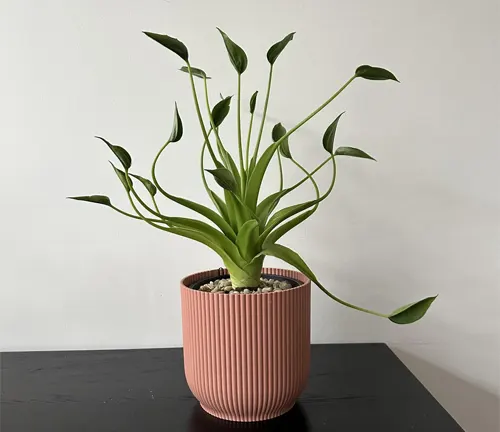
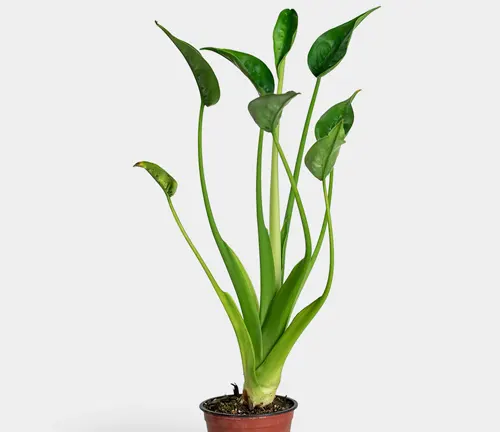
Woodland Elegance
The Alocasia Tiny Dancer Plant brings a sense of woodland elegance to any space with its lush, arrow-shaped leaves and compact size. Whether placed indoors or outdoors, this plant adds a touch of sophistication and charm to its surroundings. Its unique foliage and manageable size make it a perfect choice for enhancing the elegance of various settings.
Ecological Importance
The Alocasia Tiny Dancer Plant plays a vital role in tropical ecosystems by adding to the variety of plant life found in its natural habitat. By being part of the biodiversity in tropical regions, this plant helps maintain the balance and health of its ecosystem. Its presence contributes to the overall richness and diversity of plant species in these tropical environments.
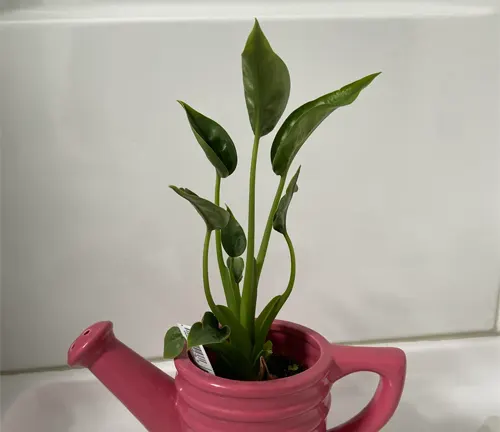
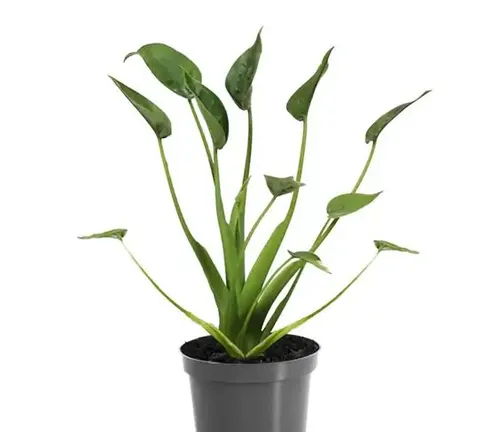
Cultivation and Conservation
The Alocasia Tiny Dancer Plant is being carefully preserved and grown because of its importance in the plant world and its beauty. People are working to protect and cultivate this plant to ensure it continues to thrive and contribute to the botanical world. Its unique characteristics and visual appeal make it a plant worth conserving for future generations to enjoy.
Fragrance
Fragrance is a lovely thing that comes from plants, flowers, and other natural sources. When we talk about the Alocasia Tiny Dancer Plant, it’s important to note that this plant is not famous for its smell but rather for its beautiful appearance. Even though it may not have a strong scent, its visual charm can still bring joy and beauty to any space it inhabits.
Plants like the Alocasia Tiny Dancer can enhance the atmosphere of a room with their unique shapes and colors. While some plants are known for their delightful fragrances, others, like this one, captivate us with their striking leaves and elegant presence. So, even if you can’t enjoy a sweet aroma from this plant, you can still appreciate its aesthetic appeal and the sense of tranquility it can bring to your surroundings.
Soil Stabilization
Soil stabilization is like giving the ground a strong foundation to stay in place and not get washed away easily. The Alocasia Tiny Dancer Plant, in its natural home, plays a helpful role in keeping the soil steady and preventing erosion. This means that the plant’s roots help hold the soil together, making it harder for wind or water to carry it away.
By stabilizing the soil, plants like the Alocasia Tiny Dancer contribute to maintaining the health of the environment. They prevent soil erosion, which can protect habitats and prevent damage to landscapes. So, while this plant may be admired for its beauty elsewhere, in its native region, it serves an important function in preserving the land and supporting the ecosystem.
Common Uses
The Alocasia Tiny Dancer Plant is often chosen to make gardens, outdoor areas, and indoor spaces look more beautiful and tropical. People like to use this plant for decoration because of its exotic and charming appearance. Whether placed in a garden or inside a home, it can bring a sense of tropical paradise to the surroundings.
Adding the Alocasia Tiny Dancer to gardens or indoor spaces can create a relaxing and visually appealing atmosphere. Its unique leaves and tropical vibe make it a popular choice for those looking to enhance their surroundings with a touch of natural elegance. So, if you want to bring a bit of the tropics into your living space or garden, this plant could be a perfect choice to add that special touch of beauty and tranquility.
Benefits
The Alocasia Tiny Dancer Plant offers various benefits that can make your surroundings more beautiful and peaceful. One of the key advantages is that it enhances the way things look, adding a touch of beauty and charm to any space it occupies. Additionally, by including this plant in your collection, you are contributing to the diversity of plants in your environment, which is essential for a healthy ecosystem.
Moreover, having the Alocasia Tiny Dancer in indoor spaces can create a calming and serene atmosphere. Its presence can help bring a sense of tranquility and relaxation to your home or office, making it a perfect choice for those seeking a peaceful environment. So, not only does this plant make your surroundings more visually appealing and diverse, but it also plays a role in promoting a peaceful and harmonious ambiance wherever it is placed.
Different Species
Alocasia macrorrhizos (Giant Taro)
Known for its gigantic leaves that can grow several feet in length, this species is a dramatic presence in any garden or large indoor space.
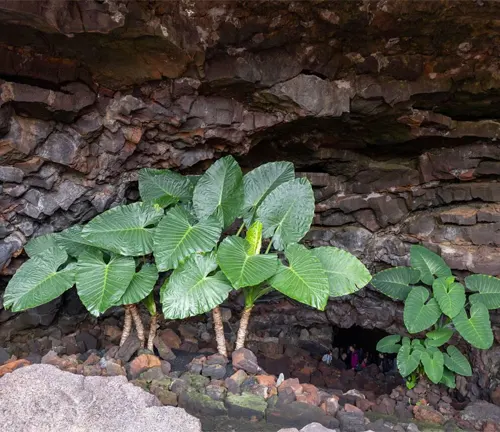
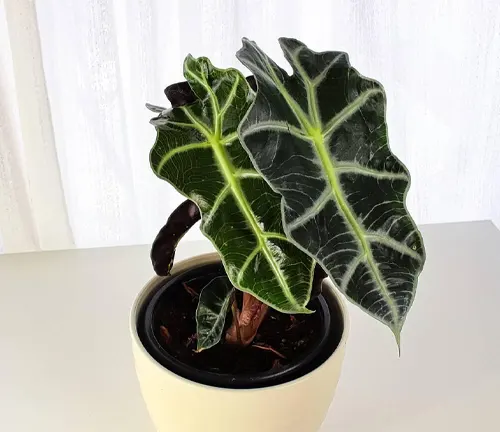
Alocasia amazonica (African Mask Plant)
With dark green leaves highlighted by bold white veins, this species is smaller than the Giant Taro but notable for its striking visual contrast and leaf shape.
Alocasia odora (Night-Scented Lily)
This species is appreciated for its large, glossy leaves and a pleasant fragrance that emanates at night, a relatively rare trait in the Alocasia genus.
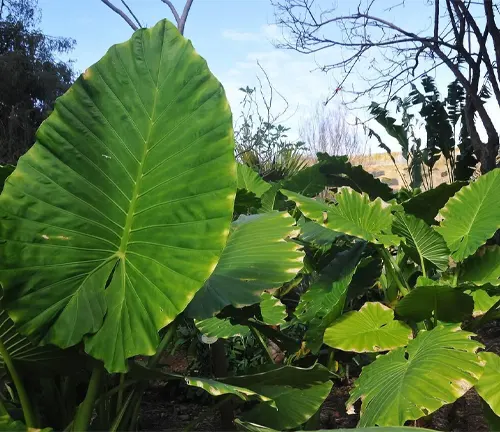
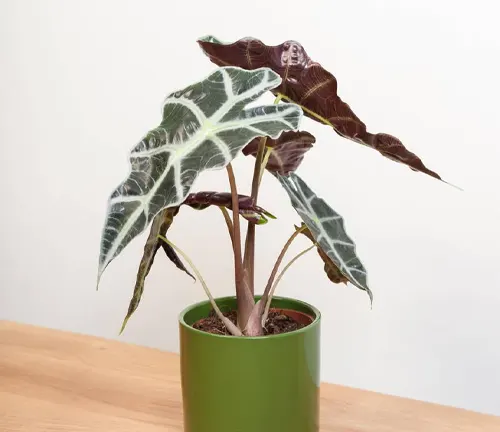
Alocasia polly (Polly Amazonica)
Similar in appearance to Alocasia amazonica but more compact, making it suitable for smaller spaces. Its deep green leaves with pronounced white veining are highly decorative.
Alocasia Cuprea (Mirror Plant)
Distinguished by its metallic-looking foliage that can range from deep green to reddish-bronze, the leaves of this species have a unique sheen that catches the light.
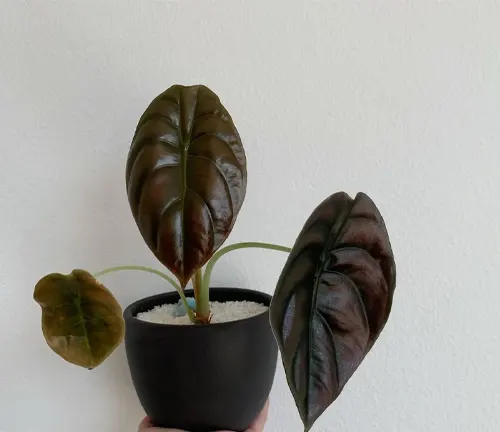
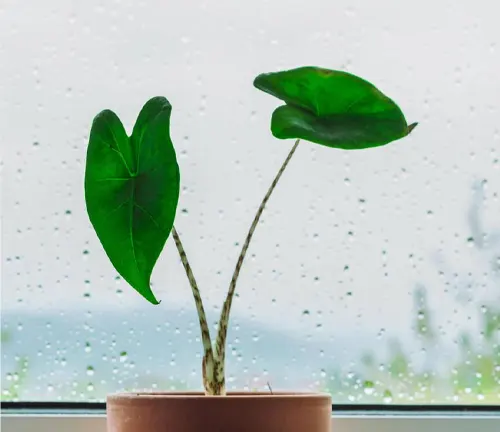
Alocasia Zebrina (Zebra Plant)
This species stands out due to its striking stem pattern that resembles zebra stripes, paired with large, arrow-shaped leaves.
Alocasia Xanthosoma (Mickey Mouse Taro)
Characterized by its large, heart-shaped leaves, some varieties have variegated foliage, adding to its appeal.
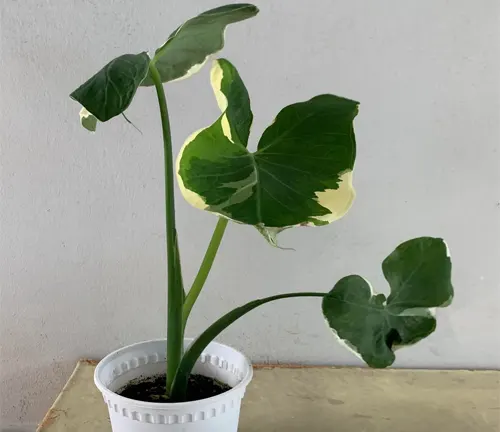
Frequently Asked Questions (FAQs)
1. What is the Alocasia ‘Tiny Dancer’ plant?
Alocasia ‘Tiny Dancer’ is a special type of Alocasia known for its unique leaves and graceful appearance. It is popular among plant lovers for its distinct features and elegance, making it a sought-after ornamental plant.
2. What does the Alocasia ‘Tiny Dancer’ look like?
This plant typically grows up to 12-18 inches tall and wide, with striking arrow-shaped leaves that have prominent veins and a glossy texture. Its compact size and unique foliage contribute to its visual appeal.
3. How do you propagate the Alocasia ‘Tiny Dancer’?
Propagation of Alocasia ‘Tiny Dancer’ is primarily done through division and sometimes through leaf cuttings. This allows for the easy multiplication of the plant for further cultivation and sharing.
4. What are the hardiness zones for Alocasia ‘Tiny Dancer’?
Alocasia ‘Tiny Dancer’ is best suited for hardiness zones 10-11. In these zones, it can thrive outdoors year-round, enjoying the warm and humid conditions.
5. Can the Alocasia ‘Tiny Dancer’ tolerate drought?
No, the Alocasia ‘Tiny Dancer’ prefers moist soil and thrives in humid conditions, making it less tolerant to drought. Regular watering is essential to keep the plant healthy.
6. Does the Alocasia ‘Tiny Dancer’ have any fragrance?
The Alocasia ‘Tiny Dancer’ is not known for its fragrance. Its appeal lies in its beautiful appearance and the visual charm of its leaves rather than any scent it might produce.
7. What are some common uses for the Alocasia ‘Tiny Dancer’?
The Alocasia ‘Tiny Dancer’ is commonly used as an ornamental plant in gardens, landscapes, and indoor spaces. Its exotic and charming appearance makes it a popular choice for decoration.
8. What ecological role does the Alocasia ‘Tiny Dancer’ play?
In its native habitat, the Alocasia ‘Tiny Dancer’ contributes to the diversity of plant species and provides habitat for various small organisms, adding to the ecological balance of its environment.
9. How does the Alocasia ‘Tiny Dancer’ benefit indoor environments?
Besides its aesthetic appeal, the Alocasia ‘Tiny Dancer’ can enhance the indoor environment by adding to the diversity of plant life and potentially improving air quality, contributing to a healthier and more beautiful living space.
10. Are there any notable species related to the Alocasia ‘Tiny Dancer’?
Yes, notable species within the Alocasia genus include Alocasia macrorrhizos (Giant Taro), Alocasia amazonica (African Mask Plant), and Alocasia odora (Night-Scented Lily), each known for its unique characteristics and beauty.



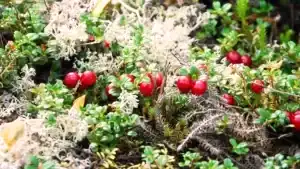

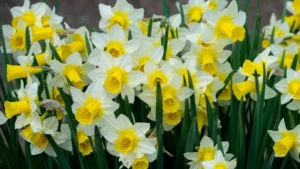


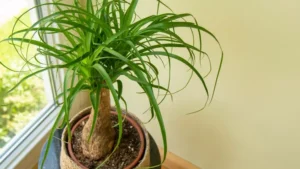
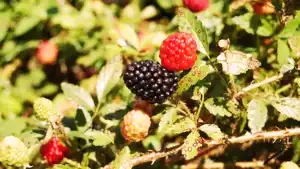


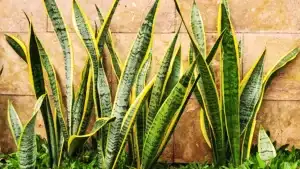

Leave your comment